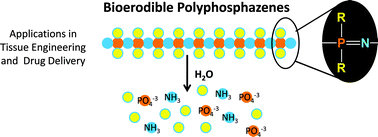Bioerodible polyphosphazenes and their medical potential
Abstract
An account is presented of the development, evaluation, and current status of an unusual series of

* Corresponding authors
a
Department of Chemistry, The Pennsylvania State University, University Park, Pennsylvania, USA
E-mail:
hra@chem.psu.edu
Fax: +814-865-3314
Tel: +814-865-3527
An account is presented of the development, evaluation, and current status of an unusual series of

 Please wait while we load your content...
Something went wrong. Try again?
Please wait while we load your content...
Something went wrong. Try again?
H. R. Allcock and N. L. Morozowich, Polym. Chem., 2012, 3, 578 DOI: 10.1039/C1PY00468A
To request permission to reproduce material from this article, please go to the Copyright Clearance Center request page.
If you are an author contributing to an RSC publication, you do not need to request permission provided correct acknowledgement is given.
If you are the author of this article, you do not need to request permission to reproduce figures and diagrams provided correct acknowledgement is given. If you want to reproduce the whole article in a third-party publication (excluding your thesis/dissertation for which permission is not required) please go to the Copyright Clearance Center request page.
Read more about how to correctly acknowledge RSC content.
 Fetching data from CrossRef.
Fetching data from CrossRef.
This may take some time to load.
Loading related content
